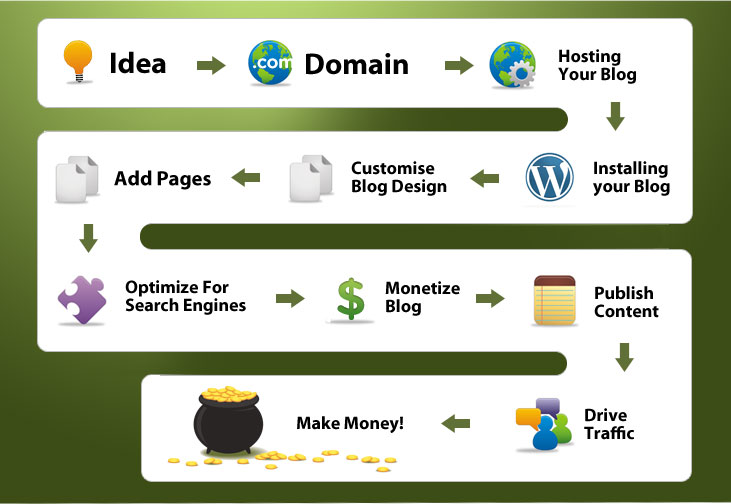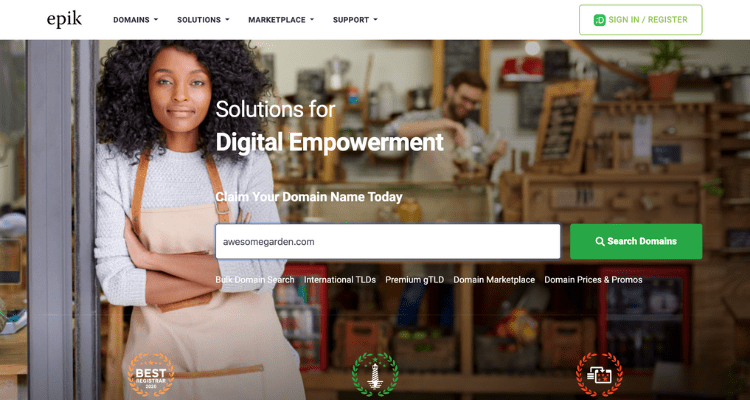
Can you still make money blogging?
Even in 2024?
Since their inception, millions of blogs have appeared and collectively made billions of dollars. (perhaps even Trillions!)
While some have enjoyed huge success, the truth is most have faded into the internet abyss!
This website is a blog.
And if you’re reading this, you’re probably wondering if blogs can still make money.
The answer?
A resounding, YES!

How To Make Money Blogging
Most of the established blogs that have survived and even thrived have been around for several years.
Some go way back to when there were just over 100,000 blogs worldwide and it wasn’t difficult to get traffic.
IncomeDiary was one of those sites
The thing is…
Blogging strategies that worked in 2010 do not necessarily work in 2024
(or at least not in the same way)
That is what we are going to cover in this updated post.
But first, let’s answer a frequently asked question:
How much money can you make blogging?
My usual answer is from Zero to Millions…
But let’s qualify that.
Most people earn nothing or very little. (Sorry!)
But I am guessing if you are reading this, you don’t want to fall into that category?
While the majority may not make it, there is a significant minority who do go on to make a significant income.
Earning enough to replace the 9 – 5 income is certainly possible.
Realistically (with application) a 4 or 5 figure monthly income is possible in your first year.
And within 2 or 3 years you could be producing a substantial 6 figure annual income. (even 7 figures).
So YES, you can still make money blogging!
An old Truth about blogging that needs updating for 2024
Conventional wisdom says bloggers should pick a topic or niche that they are passionate about, and build a blog around it.
Not a terrible idea.
(but not a great idea either!)
The problem with this approach is that what we love doesn’t always put money in the bank.
This may be what gave rise to the blogging boom that saw the launch and fall of millions of passion projects across the Internet.
The lesson?
Write about things your readers are passionate about.
And especially…
Write about issues (problems) your reader is looking to solve.
These topics are more likely to end up making you money as an affiliate.
Remember… not all niches will make you money. (and not all traffic is of equal value either)
Everything you need to know about creating a website
First things first…
The basics of launching a blog have changed little and if you are already a blogger, you will be familiar with the first 4 points below.
What has changed, however, is the implementation of those “basics”.
1. Decide what your Blog is going to be called
(and find a good domain name to go with it)

When I create a website, I don’t begin until I’ve found a domain name I think is good enough.
Sometimes it makes sense to buy a domain that has already been registered from a Domain Broker.
For example, IncomeDiary.com was bought for $100 from a fellow blogger.
And we paid $2,000 for our sister site – ExpertPhotography.com – via a domain broker.
Don’t overthink it, and don’t name your blog something random or offensive.
Keep in mind the following questions when deciding on a name:
- Does it reflect what your blog is going to be about?
- Would your target audience like it?
- Is the name easy to say and spell?
- Is it short and concise?
I recommend opting for a .com whenever possible and keeping it to three words or less.
You can register your domain name from the following, trusted registrars: HostGator
The aforementioned three registrars are established, secure and non-partisan.
Once you’ve got your domain name secured, it’s time to connect it to the world wide web.
2. To start blogging and make money set up your hosting
Now that you’ve chosen a catchy name for your blog, it’s time for step 2.
You need to sign up for a web hosting service to get your blog live and connected to the internet. We have covered this subject in detail in the past here – so I am not going to go deep into detail now.
We confidently recommend the following, secure, fast, and non-partisan web host: HostGator
You’re doing great!
Now it’s time to install WordPress.
3. To Make Publishing Blog Posts Easy – Install WordPress

You have your web host, next you need blogging software.
Most modern blogs are run on a CMS (content management system) known as WordPress.
I trust WordPress to run all of my blogs as it is user-friendly, feature-rich, and free.
Plus, you can install thousands of free and paid plugins to enhance blog functionality and customize it however you want. (Here is a guide from WPMU detailing how to add Plugins)
Click on the links below to see how to install WordPress for each of the above-mentioned hosts:
- HostGator
- Bluehost
Note: Most hosts offer 1-click installation for WordPress these days. Meaning you don’t have to worry too much about the technical side of things.
Once you’ve got WordPress installed, it’s time to design the look of your website.
4. Design Your Blog
To design a blog, you need to select an attractive and affordable WordPress theme.
Why do you need this?
Well, after signing up for WordPress, your blog will look very boring and empty.
You want it to engage by having an organized structure and visually appealing layout.
Try any of the following themes to get the look and feel you desire:
- Genesis
- XTheme
- AstraTheme
- OptimizePress (their SmartTheme is one of our favorites)
Here are 7 Website Design Features That Will Increase Profits & Usability.
You’re on a roll!
Now that you’ve got your site design applied, it’s time to begin creating content.
5. To Be A Successful Blogger – Write About Your Passions (?)
Some say,
“Write about what you love and you’ll never work a day in your life.”
OK, I may have tweaked that statement a bit to fit my narrative, but you get the idea.
Old wisdom would have you pick what you are most passionate about, then build a blog around it.
As we mentioned above, this is not a terrible idea.
But it is not a great idea either!
The problem with this approach is that what we love doesn’t always put money in the bank.
Rather, focus on solving problems for your readers.
Blog about issues that your readers are actively seeking to solve.
These topics are more likely to end up making you money.
Special Note:
If you have some cash available, now is the time to invest in training.
Sure, you can get a lot of free information from sites like this, but for niche selection, it is best to get help.
Selecting the right niche topic is critical to your success as a blogger. This training – provided by Authority Hacker is the best. (The only training we recommend)
This training will also show you how to increase your site visitors (SEO and Link Building) plus how to regularly produce engaging content.
Today, it’s better to think of blogs as a business rather than a passion project.
Once you grasp this concept, you’ll need to begin honing your copywriting skills.
Copywriting is any written content that aims to increase brand awareness and ultimately persuade a person or group to take a particular action.
Influence Intelligence is the most well-rounded Copywriting Course we’ve seen and one we highly recommend.
Special Note: When creating content for our site, we find it best to first come up with a headline and then build around that.
Related Article: 10 Writing Tips for Writing Engaging Content Your Readers Will Love.
6. To make money blogging focus on blog topics that captivate the reader
![]()
In order to create topics that captivate your audience, you’ll need to know exactly who your audience is.
You can figure this out by using the above empathy map.
Once you’ve established who your ideal user is, you’ll need to clearly articulate information to them.
You have probably noticed that Top Lists are our preferred method of blog content structure.
Top lists are concise, and specifically layout information in an easily digestible manner.
They also work well for skimmers.
If you want to increase your website traffic or encourage more email signups, you need to offer your readers interesting content.
My tip is to make a list of questions you get often (can be online or offline).
Or use a tool like UberSuggest to research the topics and keywords people regularly search for.
Trust me, within 15 minutes, you’ll come up with a bunch of potential blog topics.
Your priority should be to look at things from your reader’s viewpoint:
- Intriguing or exciting talking points
- Pain points and challenges
- Which niches appeal most
- Topics they hate
- Character traits
This is why it’s a good idea to create your ideal user avatar with the empathy map above.
Here is a breakdown of top list article writing.
And here are 10 Article Headline Examples That Got Us 10 Million Readers.
Remember the only secret to success is consistency.
7. Remain Consistent
“Find a schedule that works for you and keep at it through thick and thin.”
Today, more than ever consistency is still key. However, the problem with the above advice is that it gives the impression you can follow an arbitrary schedule and expect positive results.
Big mistake.
Instead, you may want to stick to consistently publishing high-quality posts.
For instance, Orbit Media has found that blogs that publish consistent daily posts almost always see more success [1].
This is The Most Advanced Blogging Strategy I’ve Never Shared.
8. Pivot Through Failure To Achieve Success
“Don’t mind failure and continue what you’re doing. Eventually, you’ll find success.”
This advice is similar to “remain consistent” in that it suggests not making any changes despite the obvious loss or absence of traffic to your site.
This is a surefire way to drive your fledgling blog into the ground.
While there’s merit to sticking to your guns, sometimes you need to accept you’re doing something wrong.
The term pivot has become very popular, and for good reason.
As an entrepreneur, you are going to pivot often to remain on top of trends and keep things fresh.
Blogs have to keep pace with constantly-changing SEO (search engine optimization) and UX (user experience) standards if you want lasting web traffic.
9. Don’t Forget About Your 9 to 5
“Building a blog needs you to go all in. Forget about your job and take the plunge.”
Building a blog requires a lot of time and effort if you want it to be successful.
The problem is that most people can’t afford to immediately quit their day job to write about their passions.
It’s a recipe for disaster.
Consider leveraging your current profession rather than abandoning it.
If you’re a paralegal, make a blog that helps answer people’s legal questions.
Or maybe you’re a full-time mom. Write about parenting and keeping kids entertained.
Perhaps you’re a mechanic, write about common modifications, problems, and solutions for the vehicles you work on.
The beauty here is that you can use the professional experiences you’ve established through your day job to enhance your blog.
Keep in mind that people resonate with real; so don’t lie and don’t pretend to be something you’re not.
Authenticity and transparency are two of the most important ingredients for online success.
Related: 10 eCommerce Trends Every Blogger Needs To Know About!
10. Save Money & Pay For Help
There’s nothing wrong with building your blog from the ground up yourself.
But if you’re a beginner, you may run into problems that are too big or complex to solve on your own.
It happens to ALL of us. (one of the advantages of the training we recommend is that it also gives you access to a private Facebook Group where you can ask questions about any challenges you may have)
This is why business-minded people treat a blog as a startup and outsource many of the processes to specialists.
By outsourcing your blog’s design, structure, content, social media growth, etc. you’ll have more time to spend doing everything else (like promoting your content) to make it successful.
11. Quality Over Quantity
Many blogs of the past focused on publishing multiple short posts, sometimes several times per day, in an attempt to gain traffic.
This resulted in thousands of blogs spewing millions of posts with useless and unreadable content.
Many even resorted to plagiarism to fluff their daily post quotas.
Today content is king, especially since long-form content (posts over 1500 words or more) has been found to outrank those with 1000 words or less.
You want to engage with your users.
The more time users spend on your site, the more authority you display to Google and other search engines.
Additionally, modern search engines know which website published the content first and penalize those plagiarizing or spinning (rearranging content to avoid plagiarism detection).
Related Article: Creating Blog Posts 101
12. Earn As Many Relative, Quality Backlinks As Possible

One SEO trend in the 2010s was to get as many backlinks as you could – regardless of quality.
A backlink is a link on one website pointing to your website.
They can come from social media sites and directories, but they most often come from the content of other blogs.
The more backlinks you had, the more likely your blog was to show up at the top of Google’s search pages.
This trend gave rise to websites paying money to get more backlinks despite their questionable sources.
Times have changed and all major search engines are on to them.
These days, quality over quantity doesn’t just apply to the number of words and amount of time spent writing blog content.
It extends to the quality of your backlinks as well.
Getting higher quality backlinks (backlinks from high domain authority websites) means a bigger bump to your own site’s domain authority and search engine presence.
Also, if you’re running a blog about organic gardening, getting backlinks from an automotive website doesn’t do you much good.
Search engines won’t reward you for it.
Today there’s not much argument over whether it’s better to have more backlinks or quality backlinks.
Quality wins.
This SEO Starter Guide from Google is a good place to start if you are a beginner.
Related Article: Link Building That Works, Stop Risking Your SEO
13. Great Content Attracts More Traffic
“If you write it, they will come.”
Old wisdom suggests that simply writing quality content will attract a flock of visitors to your site.
That that simply isn’t the case anymore.
Your quality post is likely to not even see the 4th or 5th page on Google.
Just like a physical product, your content has to be marketed and promoted.
You may very well need to spend more time promoting your content than you did to produce it.
Here are the 14 Things Great Content Writers Do That Average Writers Do Not.
14. Promote Your Blog
There are thousands of ways to boost website traffic, but the best is by trying something proven.
Listed below are several of the methods that currently work for attracting not only attract new users to blogs, but keep those users on the site and returning for more.
Let’s break this down into separate categories, Onsite and Offsite.
Beginning with onsite promotion:
- Resource page – Top content located in one place
- Thank you page – Encourages trust and support
- Favorite products page – List your favorite in house and affiliate products
- Repurpose Your Content – Turn your top blog posts into infographics, podcasts, and videos
- Host A 30 Day Challenge – Gets people sharing your stuff and returning for more
- Interview Thought Leaders – Positions you as an authority and encourages quality backlinks
- Run A Contest Or Giveaway – Great way to get email subscribers and social shares
- Sell An Ebook of Your Best Posts – Take your most popular posts & package them into a PDF to sell
- Require Shares for Bonus Content – Lock content until a user shares it with social media
- Experts Contribute to Roundup Post (AwesomeWeb series)
Now let’s discuss offsite promotion: (and assuming you are producing quality content)
- Ad Swaps – cross-promote a competitor or relevant business
- Use Sniply – Add a call-to-action to every link you share
- Social Media – Publish Images, videos, & in-depth posts with links to your site
- Use QR Codes – Use with any offline medium; T-shirts, posters, flyers, or even billboards
- Stumbleupon – Once users begin upvoting your content, it appears more frequently and increases traffic
- Sending Emails – Begin building your email list with PopUpDomination and send emails with MailChimp.
- Submit to Quora – People worldwide have questions you can answer with your content.
- Wear & Sell Brand Swag – Connect with a dropshipping service like Printify and model your own gear
- Posting to Medium – republish your existing content and expose it to new readers
- Answer Questions On HARO – Reporters request an expert quote, opinion, or story, then provide free publicity for their contributors
- Drive Traffic With Your Email Signatures – Add a link to a popular page or post in every email footer
- Include A Custom Link On Business Cards – Create a link with an intriguing headline and short URL to capture attention.
15. Focus On User Experience

Another trend for the early 2010s was the single-minded focus on a blog’s SEO rankings.
Many people created content to please search engines rather than their users.
This trend led to an influx of sites with poor-quality content ranking high on search engines.
That no longer works!
Search engines can tell if your content is plagiarized, keyword stuffed and overall low quality.
There are several metrics that reveal this.
For instance, the amount of time a user spends on your site, how far they scroll down a particular page, and how many other pages they view all factor into your ranking and perceived quality.
Today, you’ll find that SEO trends focus heavily on quality user experience.
16. Optimize Your Blog For Search Engines
Search engine optimization or SEO is a crucial step to earning money via blogging.
Without search engine optimization, it becomes highly improbable that you’ll make money with your blog.
Here, you will optimize your website to rank higher in search engines for specific keywords and phrases.
On WordPress, you can optimize your content and blog by downloading a plugin called Yoast SEO.
Go to the Plugins menu, and click on Add New.
Search for Yoast SEO in the search bar, and then install the plugin.
Activate it and complete the installation process.
This plugin will give you plenty of improvement tips and suggestions based on the keyword you select to help optimize your content.
I’d recommend incorporating as many suggestions as you can to improve your SEO and content readability.
17. Monetize Your Content

Now it’s finally time to make money on your content!
There are multiple ways to go about this.
Here are the most common:
- Search Ads
- Online Shop
- Sell A Service
- Affiliate Links
- Software Sales
- Resell Products
- Content Lockers
- Sell Advertising Space
- eBooks/Digital Products
Let’s break each one down…
Search Ads
Search networks are among the best places to advertise.
The search network is simple:
Someone heads to Google and searches for a topic related to a burning pain point or need.
Then, they click the ad and fill out the form or purchase the product directly.
Search ads are best when you want to capture intent.
Online Shop
You can add a shop to your WordPress blog similar to AdventureHacks.
Or you can utilize a service such as Shopify (non WordPress) which is an out-of-the-box storefront you can add a blog to.
We like WordPress and selling things in-house.
If this is the route you’d like to go as well, you can simply install the WooCommerce plugin, and immediately list products.
You can also integrate with a service such as SamCart or OptimizePress which will also allow you to list and sell your own products in-house with custom checkout pages.
WooCommerce, SamCart, and OptimizePress fully integrate with WordPress and Stripe (payment processor that accepts credit cards).
Sell A Service
Depending on the topic of your blog you could accept payment for a service.
Whether your service is physical or digital, you can add a payment link via:
Affiliate Links
This is the classic, and a method you’re likely familiar with.
There are literally thousands of affiliate networks available online.
In fact, nearly every major brand has some sort of affiliate program.
Just go to your preferred search engine, and type the name of your brand, followed by “Affiliate Program.”
What you will find is that most companies use a 3rd party to handle affiliate sales.
You may find yourself redirected to one of the following networks:




0 Comments